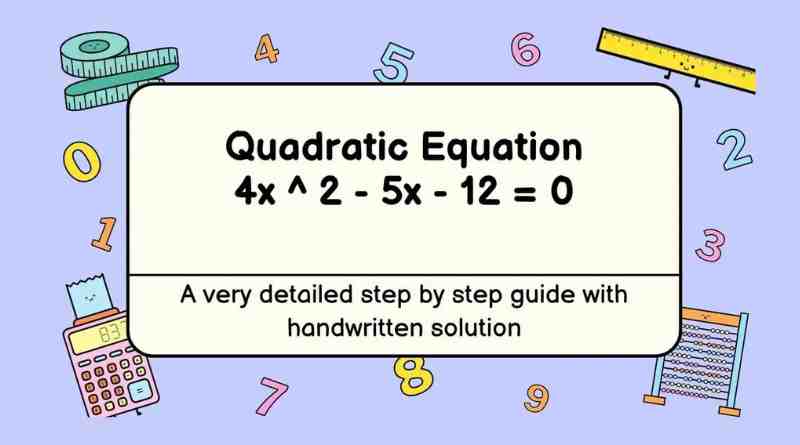4x ^ 2 – 5x – 12 = 0 | Solving The Polynomial
4x ^ 2 – 5x – 12 = 0. In this article, we will focus on solving the quadratic equation 4x^2 – 5x – 12 = 0. In algebra, solving equations is a fundamental skill that lays the groundwork for various mathematical concepts. We will explore different methods to find the solutions, understand the significance of the discriminant, and learn how to apply these techniques to real-life scenarios. So, let’s dive in and unravel the mystery of quadratic equations!
Understanding Quadratic Equation 4x ^ 2 – 5x – 12 = 0
A quadratic equation is a second-degree polynomial equation, represented in the form of ax^2 + bx + c = 0, where “x” is the variable, and “a,” “b,” and “c” are constants. In our equation, 4x^2 – 5x – 12 = 0, “a” is 4, “b” is -5, and “c” is -12.
Method 1: Factoring
Factoring is one of the primary methods to solve quadratic equations. The idea is to rewrite the equation as a product of two binomials. For example:
4x^2 – 5x – 12 = 0
(2x + 3)(2x – 4) = 0
By setting each binomial to zero, we find the solutions:
2x + 3 = 0 or 2x – 4 = 0
Solving for “x” in each case gives us:
x = -3/2 or x = 2
Method 2: Quadratic Formula
The quadratic formula provides a direct way to find the solutions of any quadratic equation. It is given by:
x = (-b ± √(b^2 – 4ac)) / 2a
For our equation, where a = 4, b = -5, and c = -12, the formula becomes:
x = (5 ± √(25 + 192)) / 8
Simplifying further:
x = (5 ± √217) / 8
Thus, the solutions are:
x = (5 + √217) / 8 or x = (5 – √217) / 8
The Significance of the Discriminant
In the quadratic formula, the term inside the square root, “b^2 – 4ac,” is known as the discriminant. The value of the discriminant provides important information about the nature of the solutions:
- If the discriminant (b^2 – 4ac) is positive, there are two distinct real solutions.
- If the discriminant is zero, there is one real solution (the graph touches the x-axis at a single point).
- If the discriminant is negative, there are two complex solutions (no real solutions).
Real-Life Applications of Quadratic Equations
Quadratic equations find applications in various fields, including physics, engineering, economics, and computer graphics. Some real-life scenarios where quadratic equations are used include:
1. Projectile Motion
When an object is launched into the air and moves along a parabolic path, its trajectory can be described using a quadratic equation.
2. Engineering and Design
Quadratic equations are used to design bridges, determine optimal shapes for structures, and predict how materials will behave under stress.
3. Finance and Economics
Quadratic equations are applied in finance to determine the optimum production level for maximizing profits or minimizing costs.
4. Optics
Quadratic equations are used in optics to design lenses and mirrors, especially in cameras and telescopes.
Conclusion
In conclusion, solving the quadratic equation 4x^2 – 5x – 12 = 0 involves using methods like factoring and the quadratic formula. Additionally, understanding the discriminant helps us interpret the nature of the solutions. Quadratic equations have significant real-life applications in diverse fields, showcasing their relevance in modern science and technology.




